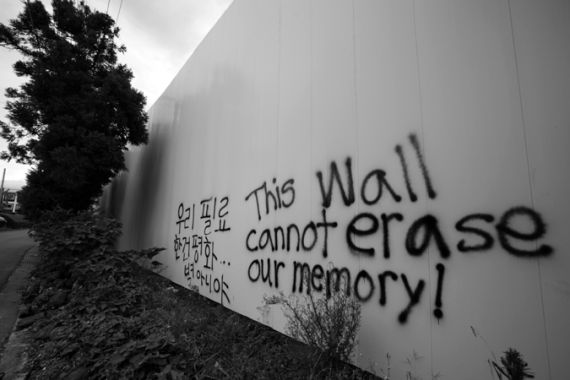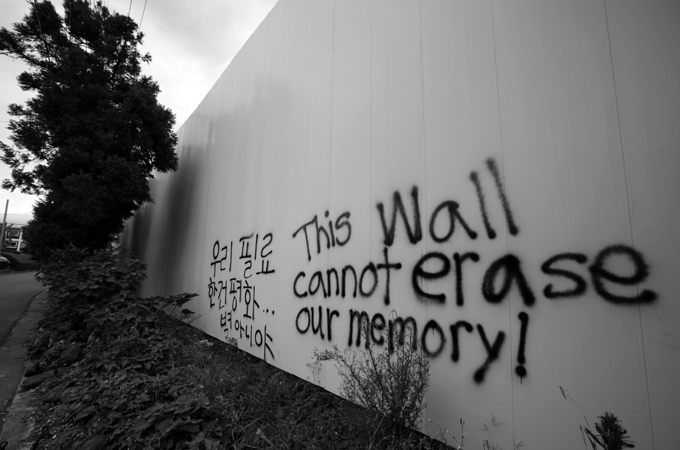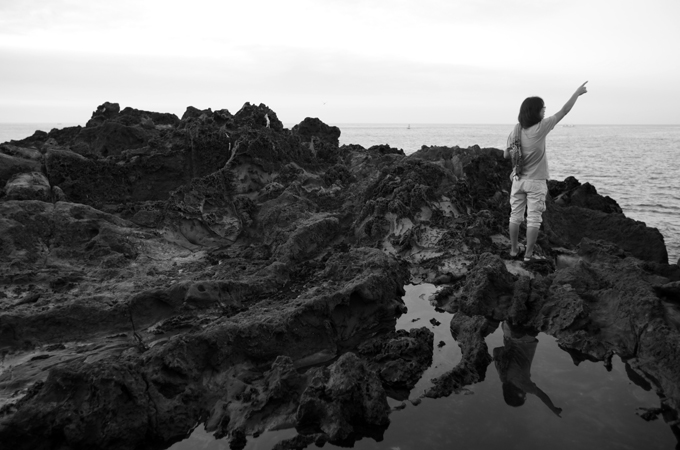
Risking everything to prevent militarisation
Filmmaker Hannah Murphy explores the violent history that has inspired one community to acts of defiance.
 |
| More than 30,000 people – 10 per cent of the population – were massacred on the island of Jeju during the Korean War |
I had never heard of the island of Jeju in South Korea before I set off to film there. At the time the issue of the construction of one of South Korea’s largest naval bases was hardly known to the rest of the world.
But as I began a period of research and communication with the anti-naval base protestors, the situation in the village of Gangjeong was rapidly escalating and drawing international attention.
This is an extraordinary story of an entire village battling to stop the construction of a geopolitical, strategic naval base serving South Korean and US interests in a region where military tensions are rising.
In what seemed like a short period of time, confrontations between the village and the authorities exploded.
One of the activists with whom I had planned to film was arrested and sentenced to eight months for lying down in front of the bulldozers. Several weeks later the mayor of the village was arrested for peacefully protesting outside the gates of the construction site. More and more villagers and activists were disappearing behind bars.
Then on September 2, three days before I was due to arrive, 1,000 riot police from the mainland descended on Gangjeong village in what was the biggest crackdown on the protestors to date.
The prevailing sense when we arrived in the picturesque and sleepy village of Gangjeong was one of despair. The core leadership of the anti-naval base campaign had been destroyed after the September 2 arrests and villagers and activists were in a state of shock.
Campaign against construction
 |
| Villagers have been holding candlelit vigils every night for the past four-and-a-half years |
Despite the sadness in the village, we received a warm welcome. On our first night, we were invited by the community to their nightly candlelit vigil to commemorate the struggle against the construction of the naval base.
This vigil has taken place in the centre of the village every night for the last four-and-a-half years. I was struck immediately by the passion, energy and resolute attitude of the villagers.
Bordering the village centre are two general stores – one opposed to the naval base and one in favour of it. On our fourth day of filming an argument broke out between the two store owners. This epitomised the disintegration of a once peaceful community.
Signs of distress caused by the construction of the naval base are palpable. Skirmishes between the police and protestors are a daily occurrence and it is not uncommon to see residents in tears.
I was told by an anti-naval base campaigner, a former member of parliament who had chained herself to the gates of the construction site, that a medical study had been carried out in the village to assess the impact on the community. It found that there was a 44 per cent increase in the suicide rate with a sharp rise in mental health problems and alcohol abuse.
What is remarkable about this protest is that it encompasses an entire community. Everyone – from the town council to local schools – has joined the protest movement, with more than 90 per cent of the village opposed to the project.
The coastline of Gangjeong is made up of a unique volcanic rock and its eerie but beautiful shoreline is home to colourful marine life. The seas around the village have been a source of livelihood for generations. But Gangjeong villagers can no longer visit their precious coastline because the navy has erected a huge wall around the construction site, cutting the residents off from the sea.
During filming, I encountered a number of people from all walks of life who are taking innovative and courageous direct action to reoccupy their coastline.
Hyun Ae Ja, a former member of the National Assembly who has chained herself to the construction site for over three months, believes that the only line of defence the villagers have left are their bodies. She gave a moving interview about the destructive impact of the naval base on the villagers, but we had to stop half way through as she broke down in tears. Formerly a farmer before she went into politics, Hyun Ae Ja knows only too well how important the land is to the people.
Speaking for the coral, fish and shells
Sung-Hee Choi gave up her career as a visual artist on the mainland to join the struggle.
She began to contribute to the effort by documenting the environmental destruction wrought, disseminating her findings to a wider international community via Facebook and blogs.
But as construction work accelerated, Sung Hee wanted to join the villagers in taking non-violent, direct action. She lay down in front of the bulldozers until the police arrested her for obstruction of business and trespass and was sentenced to eight months in prison with two years’ probation.
When I asked her why she felt the need to intervene, Sung Hee responded by quoting two old Korean sayings: “Unless you come forward, who will speak for that coral, fish, and shells that cannot speak?” and “This land we are living on is leased to us from the next generation of people.”
Acts of defiance
Every morning at dawn, Song Kang Ho swims to the construction site. He swims against a heavy tide of police and navy surveillance. It is a remarkable sight, this lone figure swimming around the headland intercepted by numerous police boats, police divers and navy security.
 |
|
Gangjeong’s rocky coastline will be flattened by the end of October 2011
|
The anti-naval base struggle continues despite the crackdowns, arrests and removal of the village’s land. The local and national police have filed more than 500 criminal charges against the villagers and activists.
It is not looking hopeful for the village of Gangjeong. Whether the will of the people will win out against government’s desire to enhance national security is still to be determined.
Song is on probation for obstruction of business and trespassing. Every time he enters the construction site, he is fined approximately $2,000. He says he is now bankrupt and has lost count of the number of fines he has accrued, but knows it is somewhere in the region of $20,000.
Every time he swims he risks a three year prison sentence. But this act is borne out of defiance against the navy’s expropriation of Gangjeong’s coastline and to exercise what was once the villagers’ right to worship their ancestors on this site.
A history of occupation
The latest update issued from Gangjeong village reports that the South Korean construction company, Daerin, are in the next phase of construction and have carried out test explosions. What is certain is that this island and this village have a history of military occupation. After Japan surrendered in 1948, the island of Jeju allied itself to the communist North during the Korean War rejecting the alliance with US.
Bolstered by the US, the South Korean government sent troops to wipe out the communist islanders. Over 30,000 men, women and children – 10 per cent of Jeju – were massacred during the Korean War.
Every family on Jeju has a memory of the killings and this helps to explain why this community will risk everything to prevent the remilitarisation of their island and the destruction of their peaceful shores.
Flattening the rocky coastline will make way for vast concrete platforms to provide docking space for up to 20 warships and submarines. October 27, 2011, is the reported date when Gangjeong’s coastline will be irrevocably destroyed.